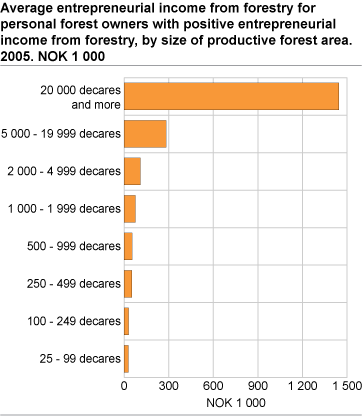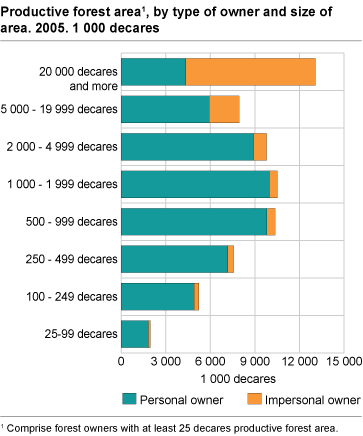Content
Published:
This is an archived release.
One in four have income from forestry
27 200 of Norwegian forest owners had entrepreneurial income from forestry in 2005. The average income from forestry was NOK 58 000.
There are 111 700 personal forest owners with a productive forest area of 25 decares or more in Norway. Their accumulated entrepreneurial income from forestry was NOK 1.6 billion in 2005. In addition, spouses of forest owners had NOK 220 million in income from forestry in the same year.
In 2005, the average gross income for forest owners with entrepreneurial income from forestry was NOK 540 000. Income from forestry accounted for 11 per cent of the gross income while other entrepreneurial income accounted for 23 per cent. Income from wages and salaries accounted for 28 per cent, and the remainder was made up of pensions and other income.
Personal forest owners own 81 per cent of the total productive forest area in Norway, and accounted for 83 per cent of the total commercial roundwood removals in 2005. 14 400 personal forest owners sold industrial roundwood in 2005. The reason why twice as many personal forest owners have income from forestry as the number of persons with commercial removals is the Norwegian tax system. Tax is imposed on the average entrepreneurial income from forestry during the last five years.
Buskerud on top
Among the forest owners with positive entrepreneurial income from forestry in 2005, forest owners from Buskerud had the highest average entrepreneurial income from forestry, at NOK 109 000. In this county, two in five forest owners had entrepreneurial income from forestry. However, Nord-Trøndelag had the highest proportion of forest owners with positive entrepreneurial income, at 46 per cent. In the three northernmost counties, only a marginal share of forest owners had entrepreneurial income from forestry. In the western part of Norway, this figure was one in ten.
Agricultural income
Three in five forest owners with positive forest income in 2005 run their own agricultural holding. The entrepreneurial income from agriculture was NOK 115 000 on average.
One in four are women
24 per cent of the personal forest owners are women, and women made up 15 per cent of the forest owners with positive forestry income in 2005. Women own 21 per cent of the productive forest area and accounted for 22 per cent of the total quantity of industrial roundwood for sale in 2005. Women's average entrepreneurial income from forestry was NOK 7 000 higher than for male forest owners.
One in five have higher education
The education level of forest owners is slightly lower than in the population as a whole. While statistics on tertiary education show that one in four in the population had higher education in 2005, this only applied to one in five forest owners. The main reason for this difference is the high average age and the low number of young women among forest owners. Among female forest owners, the education level is the same as in the population as a whole.
Forest in another municipality
One fifth of the productive forest area is not located in the municipality the owners live.
In Akershus, half of the forest owners live in another municipality than their forest properties are located.
|
Personal forest owner: When the forest is owned by an individual owner, the owner is a personal forest owner. The majority of forest owners in Norway are personal forest owners. Some properties have several personal owners. In such cases, the statistics refer to one reference person. Impersonal forest owners: Central government, common forests, local government, limited companies, foundations etc. Income statistics: Statistics based on the registers of tax assessment and personal tax return. |
Tables:
- Table 1 Average incomes, debt, gross property and assessed taxes for personal forest owners with positive entrepreneurial income from forestry. By county, size of productive forest area, sex and age. 2005. NOK
- Table 2 Income, debt, net property and assessed taxes for personal forest owners with at least 25 decares productive forest area. By county, size of productive forest area, sex and age. 2005. NOK 1000.
- Table 3 Productive forest area, by where the forest area of personal forest owners are situated
Contact
-
Terje Olav Rundtom
E-mail: terje.olav.rundtom@ssb.no
tel.: (+47) 91 38 60 61
-
Trond Amund Steinset
E-mail: trond.amund.steinset@ssb.no
tel.: (+47) 40 81 13 73




